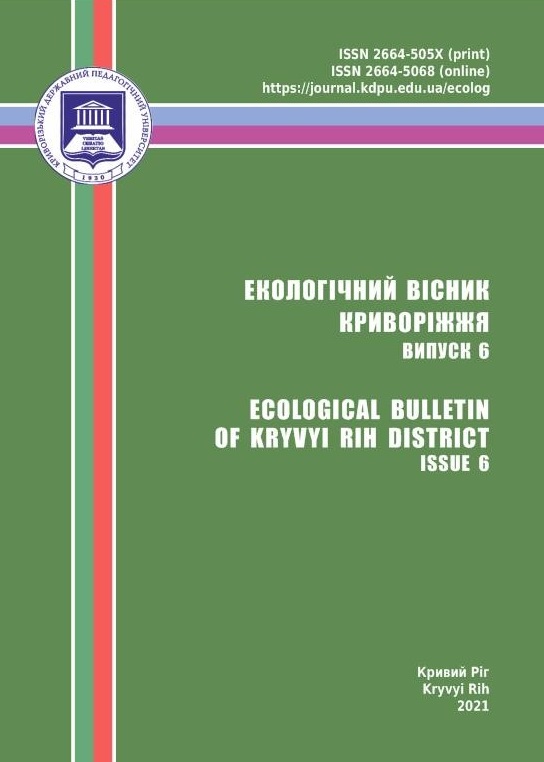АСКОРБIНОВА КИСЛОТА В РОСЛИН: МЕТАБОЛIЗМ I ФУНКЦIЇ
DOI:
https://doi.org/10.31812/eco-bulletin-krd.v6i0.4556Ключові слова:
аскорбiнова кислота, дегiдроаскорбiнова кислота, 2,3-дикетогулонова кислота, антиоксиданти, бiосинтез, деградацiя, ферменти, оксидативний стресАнотація
Аскорбiнова кислота (вiтамiн С) є найбiльш поширеним
антиоксидантом у рослинах. Охарактеризовано можливi шляхи
бiосинтезу вiтамiну С у рослин, зокрема через ГДФ-d-манозу та lгалактозу. Наведенi молекулярно-генетичнi докази, а також вiдмiнностi
вiд бiосинтезу у тваринних органiзмiв. За винятком останнього етапу,
який протiкає на внутрiшнiй мiтохондрiальнiй мембранi, бiосинтез
аскорбату у рослин вiдбувається в цитозолi. Узагальнено лiтературнi
данi щодо вмiсту аскорбiнової кислоти в тканинах i органах рiзних
сiльськогосподарських, культурних i дикорослих рослин та фактори, що
на нього впливають. Проаналiзовано особливостi метаболiзму аскорбiнової
кислоти, спiввiдношення вiдновленої й окиснених ї ї форм за рiзних
фiзiологiчних станiв, а також шляхи деградацiї вiтамiну С у рослин.
Розглянуто основнi функцiї аскорбiнової кислоти в рослинних органiзмах.
Обговорена ї ї участь як кофактора в синтезi збагачених гiдроксипролiном
глiкопротеїнiв клiтинної стiнки, роль у контролi клiтинного подiлу та
росту розтягуванням, захистi вiд активних форм кисню й оксидативного
стресу, фотоокислення та регенерацiї вторинних антиоксидантiв, таких
як α-токоферол, а також функцiонування як коферменту в рiзних
фiзiолого-бiохiмiчних процесах у рослин.
Завантаження
Metrics
Посилання
Mykiievych, I. M. (2003). Rol askorbinovoi kysloty ta fermentiv y ii metabolizmu v adaptatsii roslyn do toksychnoi dii ioniv svyntsiu [The role of ascorbic acid and enzymes of its metabolism in the adaptation of plants to the toxic effects of lead ions]. avtoreferat kandydatskoi dysertatsii). Lviv, Ukraina. (in Ukrainian).
Ostrenko, K. S., Halochkyn, V. A., Hromova, O. A., Rastashanskyi, V. V., & Torshyn, Y. Iu. (2017). Askorbat anyon — еffektyvni protyvostressovi lyhand novoho pokolenyia dlia lytyia. [Ascorbate anion is an effective new generation anti-stress ligand for lithium]. Farmakokynetyka y Farmakodynamyka. [Pharmacokinetics and Pharmacodynamics], 2, 45–55. URL: https://cyberleninka.ru/article/n/askorbat-anion-effektivnyy-protivostressovyy-ligand-novogo-pokoleniya-dlya-litiya (in Ukrainian).
Petrova, V. P. (1986). Byokhymyia dykorastushchykh plodovoyahodnykh rastenyi [Biochemistry of wild fruit and berry plants]. K.: Vyshcha shkola. (in Ukrainian).
Fedorovskyi, V. D. (2001). Ribes spicatum Robson — smorodyna kolosystaia (systematyka, heohrafyia, yzmenchyvost, yntroduktsyia). [Ribes spicatum Robson — currant (taxonomy, geography, variability, introduction)]. К.: Fitotsentr. (in Ukrainian).
Arrigoni, O., & De Tullio., M. C. (2000). The role of ascorbic acid in cell metabolism: between gene-directed function and Ecological Bulletin of Kryvyi Rih District. 2021. Issue 6 29 unpredictable chemical reactions. J. Plant Physiol., 157, 481–488. https://doi.org/10.1016/S0176-1617(00)80102-9
Conklin, P. L., & Barth, C. (2004) Ascorbic acid, a familiar small molecule intertwined in the response of plants to ozone, pathogens, and the onset of senescence. Plant Cell Environ., 27, 959–970. https://doi.org/10.1111/j.1365-3040.2004.01203.x
Davey, M.W., Van Montagu, M., Inze, D., Sanmartin, M., Kanellis, A., Smirnoff, N., Iris, J. J., Benzie, I. J. J., Strain, J., Favell, D., & Fletcher, J. (2000). Plant L-ascorbic acid: chemistry, function, metabolism, bioavailability and effects of processing. Journal of the Science of Food and Agriculture, 80, 825–860. https://doi.org/10.1002/(SICI)1097-0010(20000515)80:7<825::AID-JSFA598>3.0.CO;2-6
De Tullio, M. C., Pacciolla, C., & Arrigoni, O. (2002). Identification and analysis of sharing dehydroascorbate reductase activity. Biol. Plant., 45 (1), 145–147. https://doi.org/10.1023/A:1015145818294
Foyer, C. H., Kyndt, T., & Hancock, R. D. (2020). Vitamin C in Plants: Novel Concepts, New Perspectives, and Outstanding Issues. Antioxidants and Redox Signaling, 32 (7), 463–485. https://doi.org/10.1089/ars.2019.7819
Isherwood, F. A., Chen, Y. T., & Mapson, L.W. (1954). Synthesis of L-ascorbic acid in plants and animals. Biochem. J., 56, 1–21. https://doi.org/10.1042/bj0560001
Loewus, M.W., Bedgar, D. L., Saito, K., & Loewus, F. A. (1990). Conversion of L-sorbosone to L-ascorbic acid by a NADP-dependent dehydrogenase in bean and spinach leaf. Plant Physiol., 94, 1492–1495. https://doi.org/10.1104/pp.94.3.1492
Matamoros, M. A., Dalton, D. A., Ramos, J., Clemente, M. R., Rubio, M. C., & Becana, M. (2003). Biochemistry and molecular biology of antioxidants in the rhizobia-legume symbiosis. Plant Physiol., 133, 499–509. https://doi.org/10.1104/pp.103.025619
Matamoros, M. A., Loscos, J., Coronado, M. J., Ramos, J., Sato, S., Testillano, P. S., Tabata, S., & Becana, M. (2006). Biosynthesis of ascorbic acid in legume root nodules. Plant Physiol., 141, 1068–1077. https://doi.org/10.1104/pp.106.081463
Morell, S., Follmann, H., DeTullio, M., & Haberleim, I. (1997). Dehydroascorbate and dehydroascorbatereductase are phantom indicators of oxidative stress in plants. FEBS Lett., 414 (3), 567–570. https://doi.org/10.1016/S0014-5793(97)01074-0
Motoki, T., Yabuta, Y., Mieda, T., Rapolu, M., Nakamura, A., Maruta, T., Yoshimura, K., Ishikawa, T., & Shigeoka, S. (2007). Light regulation of ascorbate biosynthesis is dependent on the photosynthetic electron transport chain but independent of sugars in Arabidopsis. J. Exp. Bot., 58 (10), 2661–71. https://doi.org/10.1093/jxb/erm124
Mozafar, A., & Oertli, J. J. (1993). Vitamin C (ascorbic acid): uptake and metabolism by soybean. Plant Physiol., 141, 316–321. https://doi.org/10.1016/S0176-1617(11)81741-4
Nito, K., Yamaguchi, K., Kondo, M., Hayashi, M., & Nishimura, M. (2001). Pumpkin peroxisomal membranes and unknown membranous structures. Plant & Cell Physiology, 42 (1), 20–27. https://doi.org/10.1093/pcp/pce003
Ostergaard, J., Persiau, G., Davey, M.W., Bauw, G., & Van Montagu, M. (1997). Isolation of a cDNA coding for L-galactonog-lactone dehydrogenase: an enzyme involved in the biosynthesis of ascorbic acid in plants. J. Biol. Chem., 272, 30009–30016. https://doi.org/10.1074/jbc.272.48.30009
Pallanca, J. E., & Smirnoff, N. (2000). The control of ascorbic acid synthesis and turnover in pea seedlings. J. of Exper. Botany, 51 (345), 669–674. https://doi.org/10.1093/jexbot/51.345.669
Pignocchi, C., Kiddle, G., Hern´andez, I., Foster, S. J., Asensi, A., Taybi, T., & Foyer, C. H. (2007). Ascorbate oxidase-dependent changes in the redox state of the apoplast modulate gene transcript accumulation leading to modified hormone signaling and orchestration of defense processes in tobacco. Plant Physiol., 141, 423–435. https://doi.org/10.1104/pp.106.078469
Saito, K., & Loewus, F. (1992). Conversion of D-glucosone to oxalic acid and L-(+)-tartaric acid in detached leaves of Pelargonium. Phytochemistry, 31, 3341–3344. https://doi.org/10.1016/0031-9422(92)83681-N
Saito, K., Nick, J. A., & Loewus, F. A. (1990). D-Glucosone and L-sorbosone, putative intermediates of L-ascorbic acid biosynthesis in detached bean and spinach leaves. Plant Physiol., 94, 1496–1500. https://doi.org/10.1104/pp.94.3.1496
Smirnoff, N. (2003). Ascorbic acid: metabolism and function of a multifaceted molecule. Current Opinion in Biotechnology, 3, 229–235. https://doi.org/10.1016/S1369-5266(00)80070-9
Tommasi, F., Paciolla, C., de Pinto, M. C., & De Gara, L. (2001). A comparative study of glutathione and ascorbate metabolism during germination of Pinus pinea L. seeds. J. of Exper. Botany, 52 (361), 1647–1654. https://doi.org/10.1093/jexbot/52.361.1647






